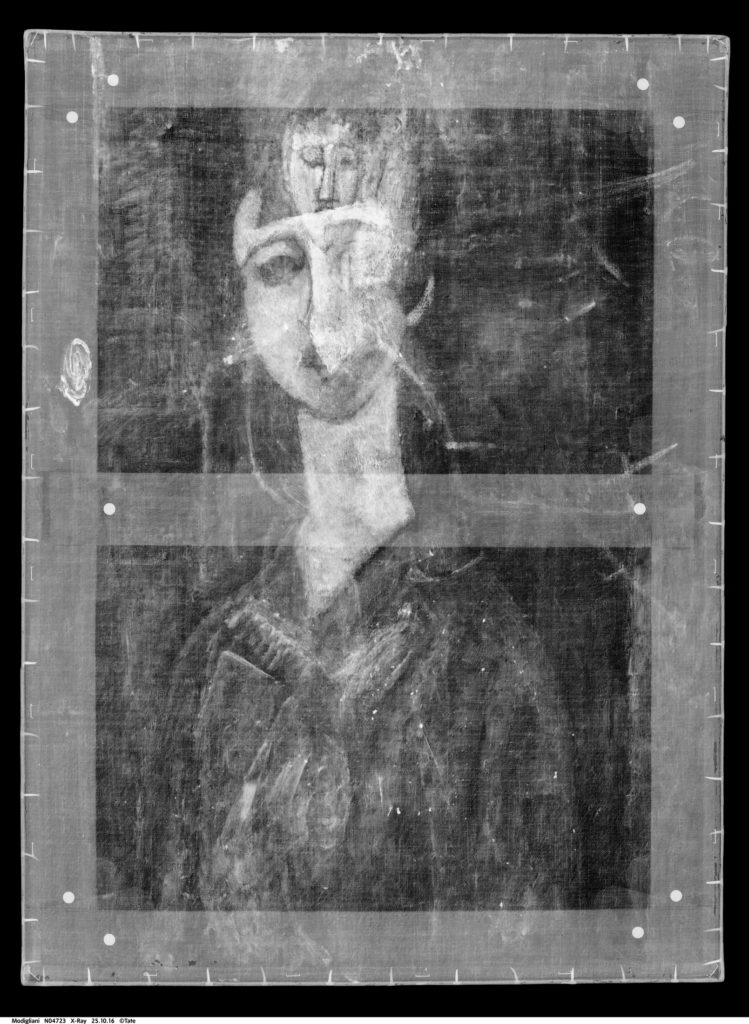
Artists paint over their finished canvases for many reasons — out of frustration at a failed design, because they lack the funds to buy more material, or even to spite whoever or whatever they’ve depicted. The latter was the case in Amedeo Modigliani’s “Portrait of a Girl” (1917), an oil painting of a sullen, seated brunette now held in the collection of the Tate. X-ray studies of the canvas conducted by the museum in 2018 revealed that the piece was originally a full-length portrait of another woman, a slender blonde with angular, elongated features. A portion of this hidden painting — now on view at Lebenson Gallery in London — was uncovered and reconstructed by two scientists using a combination of stereoscopic imaging, artificial intelligence technology, and 3D printing.
Neuroscientist Anthony Bourached and physicist George Cann joined forces in London in January 2019 to found Oxia Palus, a scientific project that uses machine learning to reconstruct what the duo calls “NeoMasters,” or artworks that have been previously hidden from view under the layers of later paintings. Their past efforts have uncovered a Blue Period nude by Picasso, a Madonna by Leonardo da Vinci, and a landscape painting by Santiago Rusiñol that was later painted over by Picasso, the artist’s friend and mentee. To discover these ‘lost’ works, Bourached and Cann apply a neural style transfer algorithm to X-rays of paintings that are suspected to have another artwork hidden below their surfaces. The technology utilizes imagery from the scan, as well as information from the artist’s other works, to reproduce colors, brushstrokes, and other distinguishing features.

Unlike conservators or other art specialists, Bourached and Cann bring uniquely non-art areas of expertise to the pieces they analyze. “George’s inspiration comes from his research on the surface of Mars for the detection of life,” Bourached explains in a recent email to Hyperallergic. “In fact, the company name is a region on Mars and is inspired by this idea of looking under the surface.”
Bourached is a researcher in neuroscience with an interest in art’s ability to educate us about history. He said that “using AI to analyze art is the inevitable next step in understanding our past better.” The team’s technology has huge implications for scholars, collectors, and art lovers alike, and complicates our concept of a true masterpiece or ‘final’ work. But Bourached is up for the challenge. “To paraphrase Alan Turing,” he wrote by email, “perhaps only a complex model can solve a complex problem.”
And who was the woman whose likeness has suddenly been unearthed more than 100 years later? She’s thought to be Modigliani’s ex-lover and muse, the English poet, writer, and literary critic Beatrice Hastings. Despite noting that the artist “looked ugly, ferocious, [and] greedy” after first meeting Modigliani in a Paris café in the summer of 1914, Hastings soon fell in love with him. The two years that the couple shared an apartment in Montparnasse were creatively productive for both: Hastings published prolifically, and is known to have posed for at least 14 of Modigliani’s portraits. But their relationship was also plagued by alcohol addictions, explosive personalities, and violent confrontations. “Even within the bohemian milieu of Paris in the 1910s, Hastings and Modigliani made a feral, wayward pair,” writes Chloe Aridjis, curator of the Tate’s 2017–2018 Modigliani exhibition.
It was perhaps to symbolically scorn his former lover that Modigliani painted over her portrait in 1917, but, thanks to the two London scientists, Hastings has found a way to see the light again. As she wrote in 1937, “Civilized woman wants something more than to be the means to a man’s life. She wants to live herself.”
The Hidden Picture continues at Lebenson Gallery (150 Curtain Road, London) through June 25.
0 Commentaires